Conventional survey methods to find rare and endangered aquatic species can be time consuming, expensive, destructive to habitat, and limited by the physical conditions of a site. Sampling for environmental DNA (eDNA) shed by organisms into their environments can overcome these limitations, maximizing conservation resources. However, the optimal spatial sampling interval for eDNA detection is poorly known. We developed and assessed eDNA methods for application to Simpsonaias ambigua (Salamander Mussel), a unionid mussel that is considered at risk throughout most of its range. We developed a quantitative PCR assay and optimized methods to detect S. ambigua eDNA in water samples, and we experimentally determined eDNA shedding and decay rates. We used these rates to populate a previously published eDNA transport model to estimate the maximum downstream distance from the source (i.e., the location of live mussels) at which eDNA could be detected as a function of environmentally relevant source eDNA concentrations and water velocities. The model predicted that maximum detection distance varied greatly depending on source eDNA concentration and water velocity. At low eDNA concentration and water velocity (1.0 copy/mL and ,0.1 m/s, respectively), eDNA will be detected only at the source, requiring spatially intensive eDNA sampling. At higher eDNA concentration and water velocity (5.0 copies/mL and 0.8 m/s, respectively), eDNA can be detected at least 10 km downstream, requiring less intensive sampling. Based on our results, we provide recommendations for the development of optimal eDNA sampling design for detecting rare or endangered species.
How to translate text using browser tools
31 October 2023
Applying Environmental DNA Methods to Inform Detection Of Simpsonaias ambigua under Varying Water Velocities in a River
Isabel Porto-Hannes,
Lauren M. Sassoubre,
Brandon J. Sansom,
Todd J. Morris
environmental DNA
rare or endangered mussel species
survey techniques





